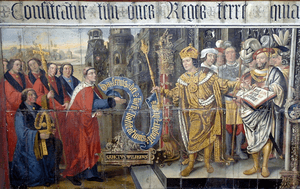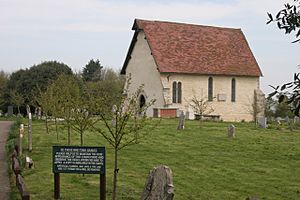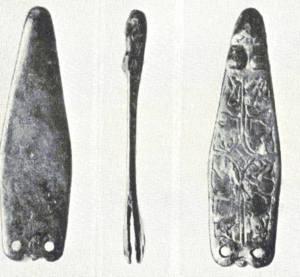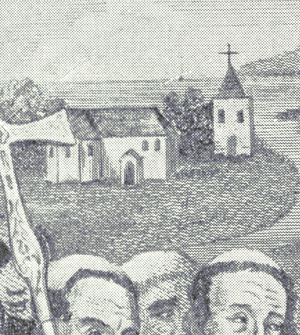Selsey Abbey facts for kids

Capitular seal with picture of Selsey Cathedral?
|
|
| Monastery information | |
|---|---|
| Order | Benedictine |
| Established | c. 681 |
| Disestablished | c. 1075 community moved to Chichester |
| Dedicated to | St Peter? |
| People | |
| Founder(s) | St Wilfrid |
| Site | |
| Location | Church Norton Selsey West Sussex England |
| Coordinates | 50°45′17″N 00°45′54″W / 50.75472°N 0.76500°W |
Selsey Abbey was an important religious place founded by a saint named Wilfrid in the year 681. It was built on land given by King Æðelwealh of Sussex. At that time, Sussex was one of the last parts of England to learn about Christianity.
The abbey became the main church for the Bishop of Sussex. This lasted until after 1075. A big meeting called the Council of London decided that important church centers, called "sees," should be in cities, not small villages. So, the bishop's seat moved from Selsey to Chichester. The abbey was likely located where the old parish church at Church Norton stands today, just north of modern Selsey.
Contents
The Story of Selsey Abbey's Beginning
Who Was Saint Wilfrid?
Saint Wilfrid of Northumbria is known for starting Selsey Abbey. Wilfrid was a religious leader who often had disagreements with kings and other bishops. Because of these arguments, he spent a lot of his life away from his home.
In 681, Wilfrid arrived in the kingdom of the South Saxons, which is now Sussex. He stayed there for five years, teaching people about Christianity and baptizing them.
Christianity Comes to Sussex
When Wilfrid arrived, some people in Sussex were already Christian. King Æðelwealh and his wife Eafe, along with some important leaders, had been baptized in a nearby kingdom called Mercia. Queen Eafe was the daughter of Wulfhere, the Christian king of Mercia.
There was also a small group of Irish monks in Bosham, led by a monk named Dicul. However, they had not been very successful in teaching the local people about Christianity. Wilfrid helped spread the Christian faith more widely across Sussex.
How Selsey Abbey Was Founded

King Æðelwealh gave Wilfrid a royal estate and a large amount of land (87 hides) to build a monastery at Selsey. One of the first things Wilfrid did was to free 250 enslaved people who lived on the estate. He then baptized them, bringing them into the Christian faith.
The Role of King Cædwalla
A later document from the 10th century says that Cædwalla, a prince from the West Saxons, confirmed the land grant to Wilfrid. Cædwalla had been forced to leave his own kingdom. During his time away, he became friends with Wilfrid. Cædwalla promised to be Wilfrid's loyal follower if Wilfrid would guide him spiritually.
Cædwalla later attacked the South Saxons and killed King Æðelwealh. Although he was driven out for a time, Cædwalla eventually became King of the West Saxons. He then conquered the South Saxons, killing their leader Berthun. Cædwalla immediately made Wilfrid his most trusted advisor.
The Abbey's Move to Chichester
Around 686, a church leader named Archbishop Theodore helped Wilfrid end his exile. Wilfrid then returned north. After Wilfrid left, Selsey Abbey became part of the Diocese of the West Saxons, based in Winchester.
By 705, the West Saxon Diocese had grown too large to manage easily. So, King Ine, Cædwalla's successor, decided to divide it. A new church center was created at Sherborne, and four years later, the See of Selsey was created.
Wilfrid had been in charge of the religious community at Selsey. When he left, he likely chose someone to lead it. Abbot Eadberht of Selsey was the leader in 709. He became the first Bishop of the South Saxons Diocese.
From Wilfrid's time until after the Norman Conquest (1066), there were about 22 bishops over 370 years. By the time of the Domesday Book (1086), the See of Sussex was one of the poorest bishoprics in England.
The bishop's seat was moved to Chichester after the Council of London in 1075. This council decided that important church centers should be in cities. Stigand, who was bishop at the time, continued to use the title "Bishop of Selsey" until 1082. He then adopted the new title "Bishop of Chichester." This shows that the move took several years to complete. Work on the new cathedral in Chichester did not start until the 1090s.
There are not many old documents about the early church in Sussex. Many of the documents that do exist are copies or even fakes. This makes it hard to know all the details of its history before the Norman Conquest.
Where Was Selsey Abbey Located?
The exact location of the old Selsey Abbey and its cathedral church is not fully known. Some local stories say it is now under the sea, and that its bell can be heard ringing during storms. This is probably not true. It might come from an old reference by a writer named William Camden. He wrote about "some obscure remains of that ancient little city... covered at high water, but plainly visible at low water."
Camden was likely talking about a reef called "The Mixon." Even though it is underwater now, it was dry land in the 11th century. This idea led to the story that the old cathedral was "drowned." Another idea is that the submerged cathedral is in an area off Selsey called "The Park." This was once a deer park owned by the Bishops of Chichester.
The Church Norton Site
It is more likely that Wilfrid's church was located at the site of what became the old 13th-century parish church at Church Norton.

There is some evidence to support this. In 1911, an excavation of a 'mound' next to the current St Wilfrid's chapel found a 10th-century bronze belt tab. This type of tab is usually found in church areas. Also, various stone objects have been found, including parts of Wilfrid's palm cross. This cross would have stood outside his cathedral. The design on the cross pieces is similar to the Bewcastle Cross. It is thought the Selsey cross would have looked just like the one at Bewcastle.
In his will from 1382, Bishop William Reade asked to be buried in front of the main altar of the church at "Selsey... once the cathedral church of my diocese." Another will from 1545, by Geoffrey Thomson, a Rector of Selsey, asked to be buried next to the palm cross in the churchyard.
A painting by the early Tudor artist Lambert Barnard hangs in Chichester Cathedral. The top left part of this painting shows the old church and bell tower at Church Norton as they looked in the 16th century. The 1911 excavation of the mound found strong stone foundations for a square tower and the remains of a ringwork (a type of early castle). It is likely these foundations were for the bell tower shown separately from the church in Barnard's painting. This tower was probably built in the 11th century or earlier as a fortification, not actually part of the church.
A church record from 1662 stated that "there was never any steeple belonging to the church [at Selsey], but a tower formerly belonging to a ruined castle, somewhat remote from the church where the bells hung..." Another important piece of evidence is a 13th-century seal from Chichester Cathedral. The picture on it is thought to show the old Selsey Cathedral. It shows a typical Saxon church with a separate tower. The old tower next to the church lasted until 1602 when it blew down. A new tower was built in 1662, this time attached to the church. The ringwork was possibly built soon after 1066. Since the bishopric did not move to Chichester until after 1075, it was likely built to protect Wilfrid's 7th-century church.
A Story of Plague and Hope
In 681, when Eappa was the Abbot (leader) of the Monastery, a terrible plague swept through the country. The monastery was also badly affected. To ask for help from God, the monks decided to fast and pray for three days.
During this time, a young boy who was sick with the plague prayed to Saint Oswald. Then, Saint Peter and Saint Paul were said to have appeared to the boy, at Oswald's request. They told him that everyone else in the monastery would be cured of the plague, except for him.
According to the historian Bede, the apostles told the boy: "Son, put aside the fear of death that is troubling you; for today we are going to take you with us to the kingdom of heaven. But first of all you must wait until the Masses are said, and you have received the Viaticum of the Body and Blood of our Lord. Then you shall be set free from sickness and death, and carried up to the endless joys of heaven. So call the priest Eappa and tell him that our Lord has heard the prayers of the brethren and regarded their fasting and devotion with favour. No one else in this monastery and its possessions is to die of this disease, and all who are now suffering from it will recover and be restored to their former health. You alone are to be set free by death today, and shall be taken to heaven to see the Lord Christ whom you have served so faithfully. God in his mercy has granted you this favour at the intercession of the devout King Oswald, so beloved by God, who once ruled the people of the Northumbrians."
See also



